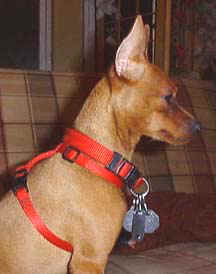
Little Dog Lost: Pet ID & Tips On Finding Your Run-A-Way
What to dog if your dog is missing.
OK, so you let little spike or princess out to sprinkle a bush and you go to the
door to call him/her back in and you notice that the gate is wide open and the
dog is nowhere to be seen.
Or you are walking your faithful companion and he/she sees something that
excites or scares him/her and you end up standing there holding a leash with an
empty collar at the end of it watching the south end of your dog heading north
at breakneck speed.
Or you've taken your family to see a live nativity scene and somehow, your pet
makes his/her break for freedom and a chance to play with the cow/sheep/whatever
other animal attracts it (sorry Terri ... couldn't resist).
What do you do?
Well the first thing is DON'T PANIC (apologies to Douglas Adams)!
The best things you can do to ensure the safe return of your pet are things you
need to do before the pet disappears/escapes.
Try to train your dog to come when called (or bribed with a treat) or at least
sit/stay so you can approach him/her. Do not ever punish your dog after coming
when called no matter what it has done before you called him/her.
Have your pet always wear a collar or harness with a current rabies tag and dog
license tag if your area requires you to get one. Even though the dog is inside
most of the time, it only takes a split second for a determined animal to dash
through a door opened only enough to take the mail from the mailman or to sign
for a package. Your dog should also have a tag with your current phone number.
While rabies tag and dog license numbers can be traced, a direct call to your
phone number requires less effort
on the part of a good Samaritan.
|
|
|
Penny owned by Joe and Theresa C. Showing off her Collar, Harness and Tags. |
You can also have your dog tattooed or micro chipped. Hair can grow over a
tattoo and a tattoo can be altered but they can be useful for identification.
Your vet can talk with you about microchips and insert one for a small fee.
Most animal hospitals and shelters have scanners and this could also help
return your pet.
Information about microchips and the AKC's companion animal recovery program
can be found at http://www.akccar.org/resources/id/microchip.cfm.
You should also have several recent clear photos of your pet from different
angles front and side.
So you've done all this and now your pet is gone, now what?
If you saw your pet escape try to follow as best you can until you regain
control or lose sight of the animal. If you have a cell phone you could call
for family members or friends to help if they are close and could get to you
quickly. Call to the dog,
do not act or sound angry. Reassure the dog that he/she is a good dog and try
to coax him/her to you. Do not run up to the animal screaming or waving
wildly. Keep in mind that the safety of the animal is your first priority and
act accordingly. Try not to chase the dog toward heavily traveled roads or
towards crowds of people or anything else that could excite or endanger the
dog.
If the animal just disappeared and you do not even know which direction it
traveled, then a little more thought is required before you leap into action.
First, look in every little hole/drain pipe/box/basement crawl
space/furniture/appliance any place big enough for the dog to have crawled
into. Animals are curious and they might be trapped or sleeping right in your
own home/yard/garage. Don't just call
- look. You might not hear them or they could be too hurt or just too busy
exploring to answer you. Make sure the dog is really gone and not just under
the porch before you go running around the neighborhood.
Have a strong flashlight handy to check places that are dark like drain pipes
and under the porch. If the pet has a favorite toy or a "special"
treat, these can be useful as lures.
Now that you're sure your pet is not under the couch, behind the fridge or
under the car. The next step is to check the neighborhood. Ride or walk around
calling the dog. Have a favorite toy and/or treat with you as well as a leash.
Stop and listen, the
dog may have squeezed through a fence into a yard and is unable to find
his/her way back out. He/she may have fallen into a drain pipe or storm drain.
You will need to listen carefully and investigate any sound that you're not
sure about.
Figure out how far you think he/she could have gone then draw a circle at
least three times that size and cover the entire area. They can cover ground a
lot quicker than we give them credit for and the quicker we find them the less
chance they will be hurt or found by someone who can't or won't return them.
After you've covered the neighborhood and still can't find your dog the next
step is to put up flyers. Flyers should contain color pictures and are best if
done on brightly colored paper to attract attention.
They should contain the dog's pictures, a complete description including age
and size, the pet's name and the date, time and location the pet was last
seen. Also include a description of any collar, harness and the size and shape
of all tags the dog was wearing.
You could also include perhaps a favorite treat for example, "Answers to
the name Lucky and likes cheddar cheese".
You will also need to be careful here as there are some not so very nice
people out there. Do not put more information in the flyer than is necessary
for someone who finds a dog like yours to consider calling you. Leave enough
out of the flyer (scars, disfigurements, special markings) so that when
someone calls they can give you enough information that you didn't put on the
flyer to make you sure that they really found your pet.
Offer a reward but do not put the amount in the flyer. If someone hasn't
really found your pet they do not need to know the amount of the reward.
Do not put any personal information about yourself in the flyer other than
your phone number. No addresses or family descriptions are necessary for
someone to return your pet if they find it. You might also offer to go and
view a pet someone has called and says might be yours. You might not want to
have people come to your house. It is not too likely, but it could be someone
who has a dog close enough to not be too suspicious and they just want to see
if you have anything worth breaking into your house to steal.
If someone, especially someone not local to you calls and tells you that they
have found your pet and it is hurt and you need to send money for medical
treatment and transportation try to confirm that it is really your pet that
they found. Next, get the
name of treating vet or animal hospital and look up the number at http://yp.yahoo.com
and call them yourself at the published number. It might not be your pet or it
might just be a scam. Try to find out as much as possible before sending any
money.
Try to go and pick up the dog yourself or have someone who would know the dog
go, rather than sending money for transportation.
The next thing you'll want to do is take your flyers and go door to door in
your neighborhood or the area where your pet was last seen. Depending on the
area and your comfort level, you might want to have a friend or family member
go with you, rather than go alone.
Always knock at the door and introduce yourself and explain what you are doing
before looking over fences or into out buildings and tool sheds for your pet.
Leave a flyer with whoever answers the door or leave one in the door jamb if
no one answers.
Ask if there are any children in the house and ask to speak with them if they
are old enough to play outside and leave the yard without adult supervision.
Kids spend more time out and about the neighborhood than most adults and can
be very effective in locating missing pets.
Speak to the mail man, paper boy, garbage men and any delivery trucks or
utility or road repair crews or utility company meter readers you may see in
your travels. They might have seen something or may be able to keep an eye out
for your pet.
Put the flyers on telephone poles between waist and eye height. At corners put
them where people in cars can see them while stopped at traffic control
signs/lights. Place them in store windows, post offices, town halls and
anywhere else people gather or p
ass by. Post them in and around parks and picnic areas.
You might also want to go to web sites like http://www.missingpet.net
and post a notice about your missing pet.
Bring flyers to local Vet offices and animal hospitals and also contact any
local chapters of a breed club and local breed rescue organizations.
Your next step is to visit local animal shelters, humane society facilities
and animal control officer offices.
Don't just call, go and visit. Descriptions mean different things to different
people. Red, brown, big, small are all open to interpretation. Show up and
bring flyers with clear, color pictures. Ask to look through the cages
yourself. Ask about microchip
scanners and if they routinely scan incoming animals if your pet is so
equipped. Find out how long they hold animals before adopting them or
euthanizing them. Make a note of it so you can check back within the allotted
time frame.
Ask them if they know any other places stray animals might be taken or who
might be called to pick them up. Follow up all leads.
Another thing you can use is the newspapers. The daily papers, especially the
Sunday edition as well as the weekly shopper type publications. Place ads
describing your dog and the date/place it was last seen. Also read the pets
found ads. You might get lucky there.
Your last resort is your local highway cleanup crews. It is sad to think about
but if your pet was struck by a car and could not recover from it's injuries,
these are the guys who would get the call. Meet them in person if you can and
treat them nice. They have a rough job and you want them to do you a favor by
calling you if they get a call for an animal that meets your pet's
description.
Above all don't give up. Your pet needs you he/she can't call you on the phone
or ask someone for help.
We will now move on to the next section of this site.
Understanding AKC Conformation Competition: Basics

 Click
Here To Join MinPinTalk
Click
Here To Join MinPinTalk

